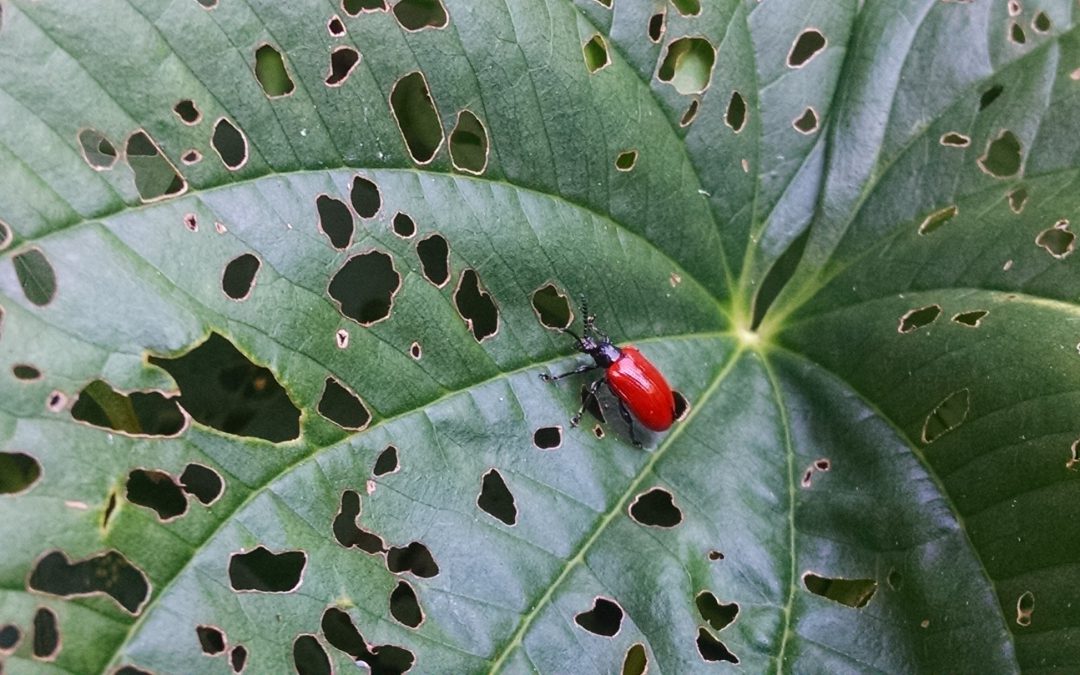
by Daniel J. Leonard | Oct 14, 2020
Article by Jessica Griesheimer & Dr. Xavier Martini, UF/IFAS North Florida Research and Education Center, Quincy
Dioscorea bulbifera, commonly known as the air potato is an invasive species plaguing the southeastern United States. The air potato is a vine plant that grows upward by clinging to other native plants and trees. It propagates with underground tubers and aerial bulbils which fall to the ground and grow a new plant. The aerial bulbils can be spread by moving the plant, causing the bulbils to drop to the ground and tubers can be spread by moving soil where an air potato plant grew prior. The air potato is commonly confused with and mistaken as being Dioscorea alata, the winged yam which is also highly invasive. The plants look very similar at first glance but have subtle differences. Both plants exhibit a “heart”-shaped leaf connected to vines. The vines of the winged yam have easily felt ridges, while the air potato vines are smooth. They also differ in their aerial bulbil shapes, the winged yam has a long, cylinder-shaped bulbil while the air potato aerial bulbil has a rounded, “potato” shape (Fig. 1).
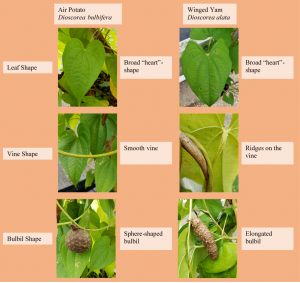
In its native range of Asia and Africa, the air potato has a local biocontrol agent, Lilioceris cheni commonly known as the Chinese air potato beetle (Fig. 2). As an adult, this beetle feeds on older leaves and deposits eggs on younger leaves for the larvae to later feed on. Once the larvae have grown and fed, they drop the ground where they pupate to later emerge as adults, continuing the cycle. The Chinese air potato beetle will not feed on the winged yam, as it is not its host plant.Current methods of air potato plant, bulbil, and tuber removal can be expensive and hard to maintain. The plant is typically sprayed with herbicide or is pulled from the ground, the aerial bulbils are picked from the plant before they drop, and the underground tubers are dug up. The herbicides can disrupt native vegetation, allowing for the air potato to spread further should it survive. If the underground tuber or aerial bulbils are not completely removed, the plant will grow back.
The Chinese air potato beetle is currently being evaluated as a potential integrated pest management (IPM) organism to help mitigate the invasive air potato. The beetle feeds and reproduces solely on the air potato plant, making it a great IPM organism choice. During 2019, we studied the Chinese air potato beetle and its ability to find the air potato plant. It was found the beetles may be using olfactory cues to find the host plant. Further research is conducted at the NFREC to increase natural aggregation of the beetles on air potato to improve biological control of the weed.
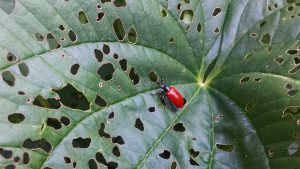
Chinese Air Potato Leaf Beetle.
If you have the air potato plant, or suspect you have the air potato plant, contact your local UF/IFAS Extension Agents for help!
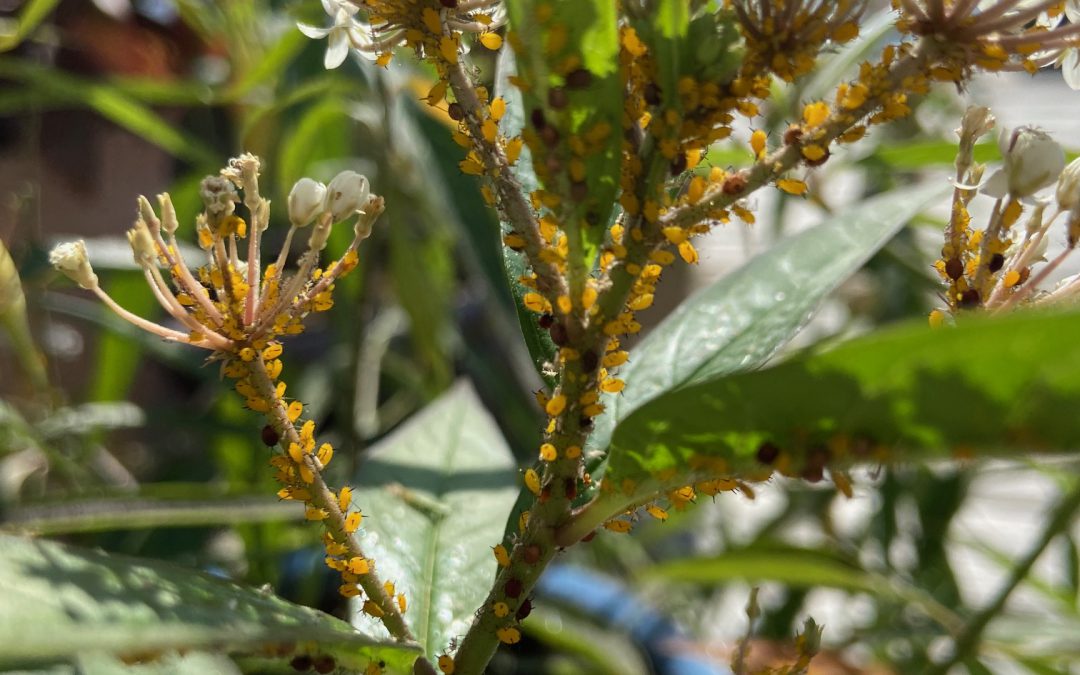
by Mary Salinas | Sep 8, 2020
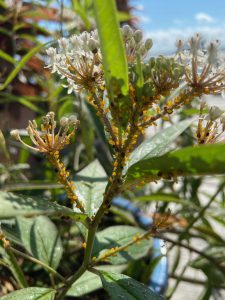
Perennial milkweed, Asclepias perennis, with oleander aphids; notice the brown aphid mummies that have been parasitized. Photo credit: Mary Salinas UF/IFAS Extension.
Milkweeds are appreciated for their beauty, but often we cultivate it for the benefit of the monarch butterflies who lay their eggs only on this plant genus. Avid butterfly gardeners want the monarch caterpillars to eat up the milkweed and become beautiful butterflies. Often instead, thousands of aphids show up and compete for space on the plants. These bright yellow aphids are known as oleander aphids.
Just how do aphids build up their populations so quickly? It seems that one day you have a small number on a few plants and then a few days later, thousands are all over your milkweed. Oleander aphids have a few advantages for quickly building their populations:
- All oleander aphids are female and do not need to mate to produce their young
- Aphids give birth to live young who immediately start feeding on the plant
- Aphids start reproducing when they are 4 to 10 days old and keep reproducing during their one-month life span
- When populations get heavy or the plant starts to decline, winged individuals are produced to migrate to new areas and plants.
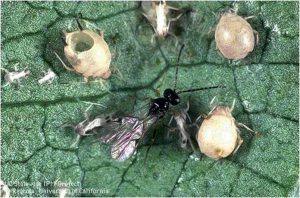
Parasitic wasp and aphid mummies. Photo credit: University of California.
What can or should you do to control this pest?
One option is to do nothing and let the natural enemies come in and do their job. One of the best is a very tiny wasp that you will likely never see. This parasitoid lays its eggs only inside aphids. The wasp larva feeds on the inside of the aphid and turns it into a round brown ‘mummy’ and then emerges when mature by making a round hole in the top of the aphid. Look closely with a hand lens at some of those brown aphids on your milkweed and you can see this amazing process. Another common predator I see in my own garden is the larvae of the hover fly or syrphid fly. You will have to look hard to see it, but it is usually there. Assassin bugs and lady beetles also commonly feed on aphids. The larvae of lady beetles look nothing like the adults but also are voracious predators of aphids – check out what they look like.
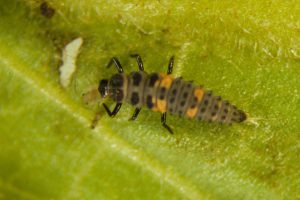
Lady beetle larva feeding on aphid on tobacco. Photo credit:
Lenny Wells University of Georgia Bugwood.org.
If you think your situation requires some sort of intervention to control the aphids, first check carefully for monarch eggs and caterpillars, keeping in mind that some may be very small. Remove them, shoo away any beneficial insects, and spray the plant completely with an insecticidal soap product. Recipes that call for dish detergents may harm the waxy coating on the leaves and should be avoided. The solution must contact the insect to kill it. Always follow the label instructions. Soap will also kill the natural enemies if they are contacted. One exception is the developing wasp in the aphid mummies – fortunately, they are protected inside as the soap does not penetrate. Oils derived from plants or petroleum can serve the same purpose as the insecticidal soap.
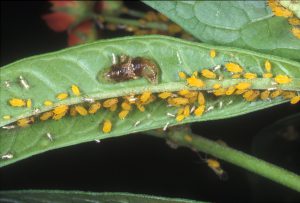
Syrphid fly larva and oleander aphids. Photo credit: Lyle Buss, University of Florida.
You also can squish the aphids with your fingers and then rinse them off the plant. If you only rinse them off, the little pests can often just crawl back onto the plant.
There are systemic insecticides, like neonicotinoids, that are taken up by plant roots and kill aphids when they start feeding on the plants. However, those products also kill monarch caterpillars munching on the plant and harm adult butterflies, bees, and other pollinators feeding on the nectar. So those products are not an option. Always read the product label as many pesticides are prohibited by law from being applied to blooming plants as pollinators can be harmed.
In the end, consider tolerating some aphids and avoid insecticide use in landscape.
Happy butterfly gardening!
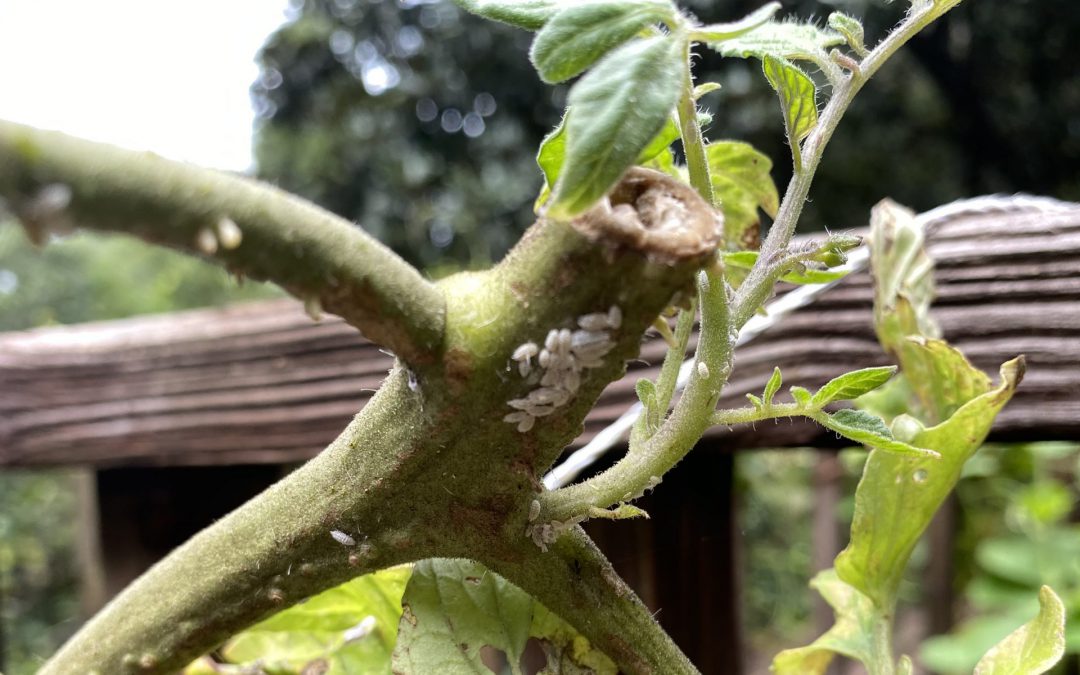
by Matt Lollar | Aug 24, 2020
A common question for gardeners at the end of the season is if one should till the soil or use no till practices. Opinions vary regarding this question, even among Extension Agents. However old crops harbor insects, both good and bad. This phenomenon was noticed on some recently cut back tomato plants. The intention was to cut the leftover spring garden tomatoes back to encourage fall production. Instead, a host plant for mealybugs was provided.

Mealybugs on a tomato plant. Photo Credit: Matt Lollar, University of Florida/IFAS Extension – Santa Rosa County
Mealybugs are soft-bodied insects that possess a covering of flocculent, white, waxy filaments. They are about 1/8 inch in length and usually pinkish or yellowish in color. Mealybugs have piercing-sucking mouthparts which they use to siphon fluids from the leaves, stems, and sometimes roots of many ornamental and vegetable plants. Mealybug damage produces discolored, wilted, and deformed leaves.
One very common example of an insect pest likely to claim residence in your garden’s crop residue, are squash bugs. They like to overwinter on squash, cucumber, and other cucurbit crop residue. If you choose to not till your garden and leave a portion of last seasons crop in your garden, then you should consider applying an insecticide to your spent crop at the end of the season. A product containing a pyrethrin or pyrethroid as an active ingredient would be a good broad spectrum insecticide to control any pest that may reside on plant residue. More information on pyrethrins and pyrehtroids can be found at the EPA webpage: Pyrethrins and Pyrethroids. If you choose to apply an insecticide, it is important that you follow the information on the label regarding pollinator protection. Another option is to plant a trap crop on the edge of your garden to help attract pest insects away from your desired crops. More information on trap crops can be found in the EDIS Publication: Intercropping, Pest Management and Crop Diversity.

An adult squash bug on a zucchini leaf. Photo Credit: Matt Lollar, University of Florida/IFAS Extension – Santa Rosa County
So the answer to the till or no till question is…it depends. It is really up to the gardener. Yes, the residue from crops will add nutrients and organic matter to your soil, but it could also increase pest pressure in your garden. If you don’t plan to remove crop residue and don’t plan to till, then keep an eye out for what could be hiding in your garden.
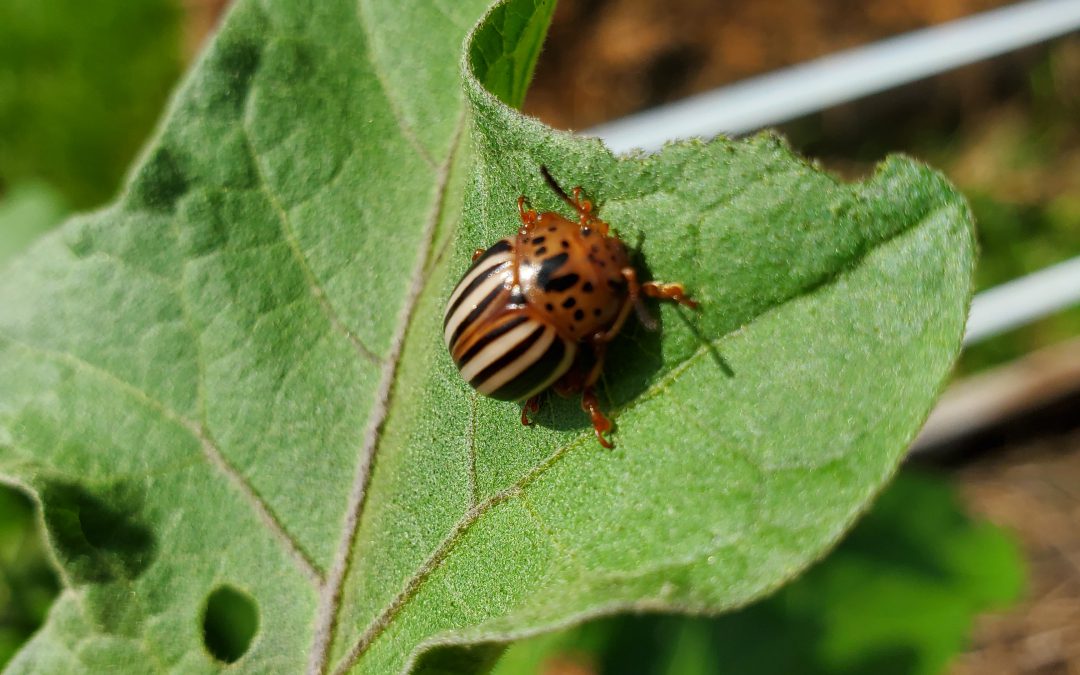
by Daniel J. Leonard | Aug 24, 2020
August is awful. Its heat makes one miss the relative cool of July. Its rain is so sporadic that it invokes nostalgia for the rainy afternoons of early summer. But if there is a silver lining in August for gardeners, it is the simplicity that it brings. The weaker spring crops, tomatoes, squash and the rest, are all gone now, destroyed or rendered fruitless by insects, disease, and heat. This leaves only the hardened, usually pest and disease-free survivors Okra, Pepper, Sweet Potato and Eggplant. I say usually because, this year, my eggplant bed is under attack by a new-to-me pest, the False Potato Beetle!
I’ve dealt with Colorado Potato Beetles (CPB) before. Those orangish, black-striped terrors often attack my spring potato crops and occasionally bother early tomatoes. However, I’ve never seen them in late summer on Eggplant. This raised suspicion. Also, I spotted unusual, round, whitish purple creatures munching on leaves from the same plants; these appeared to be the larval stage of the unidentified beetle. A little digging led me to identify these garden pests as the lesser known, lookalike cousin of CPB, the False Potato Beetle.
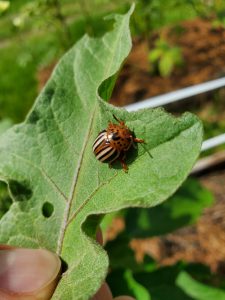
False Potato Beetle munching on an Eggplant leaf in the author’s garden.
False Potato Beetle (FPB) looks nearly identical to its cousin in the adult stage. They are similarly shaped and colored, though a close look reveals subtle differences between species. While both have yellowish-orange heads and pale-yellow backs with dark stripes, the FPB’s back is slightly lighter hued, more of a whitish, cream color. Also, the CPB’s underside and legs are a very dark orange to brown, with the False Potato Beetle having lighter colored legs and underside. If you’re saying, “These old eyes will never be able to tell the difference, County Agent. Cream and light-yellow look the same to me.”, I get it. Fortunately for those of us with poor vision, the larval stage (babies) of the two beetles looks very different and is the key to correct ID! FPB larvae are larger and have a whitish coloration. CPB larvae, in contrast, are a similar burnt orange color to the adult beetle. I promise, the difference is very distinguishable!
False Potato Beetle is considered a minor garden and agronomic pest as they typically only bother Eggplant, and they don’t usually destroy entire plants. However, if you get a FPB outbreak in your Eggplant garden, they can still be pretty destructive. These beetles feed in the same manner as caterpillar pests, chewing away entire sections of leaves and stems. Unchecked infestations can defoliate entire sections of plants. So, if you find these little beetles eating away at your eggplant garden, what can you do?

False Potato Beetle larvae. Photo courtesy of the author.
First, if you scout regularly, you’ll notice the beetles and their larvae in relatively small numbers before outbreaks become widespread. I had pretty good success this year just catching infestations early and picking off the beetles I saw and squishing them. Continue scouting and squishing for a few days and pretty soon, the population is reduced to a manageable level. However, if squishing makes you squeamish, you also have some common pesticide options at your disposal. I normally encourage clients to start their chemical pest control strategy with “softer” products like Pyganic, a pyrethrin make from an extract from the Chrysanthemum plant. Pyganic works great but is a little harder to find; you may have to order online or ask your local retailer if they can get it for you. If you are unable to find Pyganic or it doesn’t perform for you, the old standby products with carbaryl or pyrethroids (Sevin, Ortho Bug-B-Gone, and others) also work well.
False Potato Beetle can be a late summer garden pain, but with regular scouting, proper insect ID, lots of squishing, and maybe a timely pesticide application or two, you should be able to continue to harvest eggplant deep into fall! If you have FPB in your garden or have another horticultural question, give your local UF/IFAS County Extension office a call! Happy Gardening!

by Larry Williams | Aug 14, 2020
Oleander caterpillars, which are active on some oleanders during summer, can provide a number of gardening lessons.
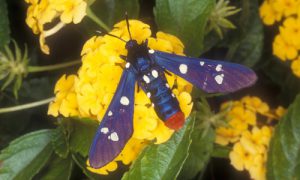
Oleander caterpillar moth on lantana flower. Photo credit: James Castner, UF
The adult moth is striking in appearance. The bluish to purplish moth has white dots on its black wings. The moths resemble wasps as they fly in and around oleander shrubs.
It’s the orange caterpillars with black spots and black hairs that cause problems for some gardeners.
Caterpillars are the larval stage of butterflies and moths. In order to enjoy watching butterflies and moths feeding on the nectar of flowers, some of the caterpillars must survive to become adult butterflies and moths. This is lesson number one.
Oleander caterpillars usually only feed on oleander plants. Oleanders are native to areas of Europe and Asia. This is lesson number two.
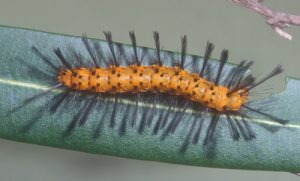
Oleander caterpillar, Photo credit: Paul Choate, UF
Oleander caterpillars benefit by us planting their food source in Florida.
This relationship between pest and plant is referred to as the key plant, key pest concept. Some other examples include St. Augustinegrass and chinch bugs, gardenias and whiteflies, crape myrtles and crape myrtle aphids, azaleas and azalea caterpillars, camellias and tea scale, roses and black spot, pecans and pecan scab, squash and squash vine borers.
Understanding this concept can be helpful in designing a “low maintenance” landscape.
When you plant roses, you plant everything that goes with roses, including the time and money required to maintain them. This applies to St. Augustinegrass, pecan trees, squash and oleanders. This is lesson number three.
Oleander caterpillars can temporarily damage the appearance of oleanders. But they cause no long-term damage for the plant. This is lesson number four. The damage is aesthetic. Oleander caterpillars can consume great numbers of leaves. However, if the plant is otherwise healthy, new leaves will be produced and the plant will continue to grow. The damage is temporary; there will be no evidence the plant ever had a problem.
To spray or not to spray for oleander caterpillars has to do with a person’s tolerance level.
If you can’t tolerate having oleander caterpillars around and the temporary aesthetic damage they cause, consider the use of Bacillus thuringiensis. It is sold under a number of brand names and many times is referred to as Bt. This bacterium only controls caterpillars so it is friendlier for the beneficial insects. When using any pesticide, always follow the label directions and precautions.
Here are links to UF/IFAS Extension publications with more info.
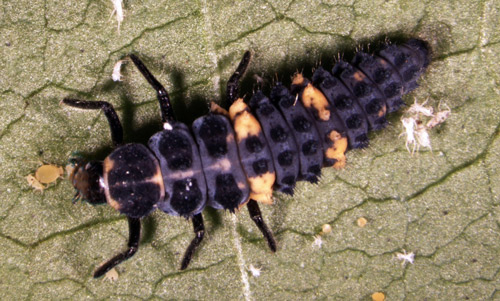
by Daniel J. Leonard | Aug 6, 2020
I know this is going to come as a shock to some readers, but not all bugs are bad. In fact, while there are over 1 million species of insects worldwide, less than 1% are problem pests! This problem 1%, composed of common garden pests, including aphids, stinkbugs, nuisance caterpillars, and scales, get all the attention and for good reason; they can be extremely destructive to home and commercial crops. However, the good guys, beneficial predatory insects, are out there too, providing valuable pest control day and night and should be considered in part of a quality garden pest management strategy.
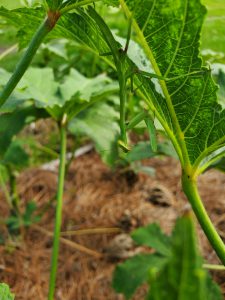 Beneficials come in many shapes and sizes. Some are commonly known predators, such as spiders, Lady Beetles and Praying Mantids, while others are lesser known pest nemeses, like Paper Wasps, Pirate Bugs, and Lacewings. Regardless, gardeners should do their homework and be able to identify beneficials when they see them and allow them to do their jobs. The presence, or not, of a handful of Lady Beetles or Lacewings on the attack can be the difference between needing to treat with insecticides for an aphid outbreak or just letting nature take its course. Studies have shown that just one individual Lady Beetle in the larval stage can consume as many as 500 aphids; adult Lady Beetles are even hungrier aphid eaters! Paper Wasps, you know the ones who make the large “papery” nests around eaves of house and other structures, play an important beneficial role, frequently preying on caterpillars. If their nests aren’t near highly trafficked areas around your home and you don’t have family members allergic to wasp stings, your garden will thank you for leaving a few paper wasp colonies as caterpillar insurance!
Beneficials come in many shapes and sizes. Some are commonly known predators, such as spiders, Lady Beetles and Praying Mantids, while others are lesser known pest nemeses, like Paper Wasps, Pirate Bugs, and Lacewings. Regardless, gardeners should do their homework and be able to identify beneficials when they see them and allow them to do their jobs. The presence, or not, of a handful of Lady Beetles or Lacewings on the attack can be the difference between needing to treat with insecticides for an aphid outbreak or just letting nature take its course. Studies have shown that just one individual Lady Beetle in the larval stage can consume as many as 500 aphids; adult Lady Beetles are even hungrier aphid eaters! Paper Wasps, you know the ones who make the large “papery” nests around eaves of house and other structures, play an important beneficial role, frequently preying on caterpillars. If their nests aren’t near highly trafficked areas around your home and you don’t have family members allergic to wasp stings, your garden will thank you for leaving a few paper wasp colonies as caterpillar insurance!
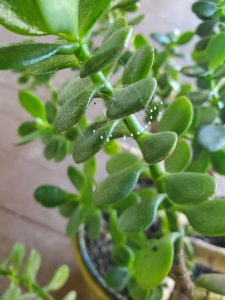
Lacewing eggs on a Jade plant in close proximity to the author’s vegetable garden.
In many instances, beneficial insects can keep pest insect infestations at bay, allowing gardeners to spot treat outbreaks when they get out of hand or even prevent the problem from needing chemical intervention altogether.
As helpful as they are, beneficial insects in the garden won’t totally negate the need for chemical treatment entirely. From time to time, garden pest populations outpace the beneficials’ abilities to kill them and intervention from humans is needed. In these times, it is advisable to use a couple of best practices to limit exposure to beneficial insects. First, try to use selective insecticides that only target specific pests and are nontoxic to other bugs, like the product Bt for caterpillar pests (sold under many brands like Dipel, Garden Safe Bt Worm and Caterpillar Killer, Thuricide, etc). However, if a nonselective, general insecticide, like the Pyrethroids (many common homeowner insecticide brands) and carbamates (Sevin and others), is needed, timing these broad spectrum sprays for early in the morning and late in the evening when many beneficials are not very active can help reduce friendly fire casualties. Care should also be taken to only spot treat infested plants and not the entire garden, this helps reduce beneficial exposure to these broadly toxic pesticides.
Every gardener should have a plan for pest control and beneficials can play an important role in this overall strategy. Gardeners can help ensure that nature pulls its weight in controlling problem pests by taking a little time to scout for beneficial insect populations, keeping a close eye on developing pest outbreaks, using selective insecticides when you can, and only spraying broad spectrum products as spot treatments when necessary and timing those applications for very early or late in the day. If you have a question about whether or not a garden insect is a good guy or a pest or want more information on garden pest control strategies, contact your local UF/IFAS County Extension Office! Happy Gardening!
The following resources were used in the development of this article:
https://gardeningsolutions.ifas.ufl.edu/care/florida-friendly-landscapes/beneficial-insects.html
https://sfyl.ifas.ufl.edu/sarasota/gardening-and-landscaping/horticulture-commercial/integrated-pest-management/beneficial-insects/
http://www.missouribotanicalgarden.org/gardens-gardening/your-garden/help-for-the-home-gardener/advice-tips-resources/pests-and-problems/other/beneficial-insects.aspx




















